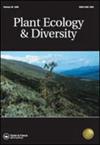热带安第斯山脉植物功能多样性páramos
IF 1.7
4区 生物学
Q2 PLANT SCIENCES
引用次数: 34
摘要
摘要背景:热带高山存在极端的日温度变化、频繁的高空气蒸发需求和土壤水分有效性的季节性差异。植物通过不同的回避-容忍机制来适应这些条件。本文综述了植物的生长形式及其适应策略。目的:通过对páramo植物性状的综合综述,了解植物生长形式在环境气候和土地利用变化下的功能及其对生态系统特性的影响。方法:从抗冻性、水分关系和气体交换特性三个主要方面考虑,植物的反应沿着回避-容忍梯度呈现。对委内瑞拉安第斯山脉高海拔梯度45种草本植物和42种木本植物的研究结果进行了分析。结果:叶片过冷是木本植物对夜间冰冻温度的常见回避反应,而草本植物则能耐受霜冻。与更具耐受性的草本植物相比,树木和茎生莲座在缺水条件下保持了更多的正叶片水势。所有植物生长形态在旱季条件下均表现出较强的气孔控制。结论:Páramo植物的生长形式在水分亏缺和低温抗性反应中可能按照回避-耐受梯度进行分离。木本植物的生长形式倾向于避免冰冻和水分胁迫,而草本植物的生长形式则能忍受霜冻并抵抗不利的水分状况。草和垫层植物在坡度的容忍极限,并且在páramo都达到了最高的海拔。安第斯巨型莲座植物是抗冻植物,特别容易缺水,在所有生长形式中最容易受到环境条件变化的影响。本文章由计算机程序翻译,如有差异,请以英文原文为准。
Plant functional diversity in tropical Andean páramos
ABSTRACT Background: Tropical high mountains present extreme daily temperature variations, frequent high air evaporative demands and seasonal differences in soil water availability. Plants have adapted to these conditions through different avoidance-tolerance mechanisms. This review focuses on plant-growth forms and their adaptive strategies. Aims: This integrated review of páramo plant traits aims at contributing to understanding the functioning of plant-growth forms and their significance on ecosystem properties under environmental climate and land-use changes. Methods: Plant responses are presented along avoidance-tolerance gradients considering three main aspects: freezing resistance, water relations and gas exchange characteristics. Results from 45 herbaceous and 42 woody species along elevational gradients in the Venezuelan high Andes were analysed. Results: Leaf supercooling is the common avoidance response of woody plants to night-time freezing temperatures, while herbaceous plants tolerate frost. Trees and caulescent rosettes maintain more positive leaf water potentials under water deficit conditions compared to more tolerant herbaceous species. All plant growth-forms showed strong stomatal control under dry-season conditions. Conclusions: Páramo plant growth-forms may be separated according to an avoidance-tolerance gradient in response to water deficit and low temperature resistance. Woody growth-forms tend to avoid both freezing and water stress, while herbaceous forms tolerate frost and resist an unfavourable water status. Grasses and cushion plants are at the tolerant extreme of the gradient and coincide in that both reach the highest elevations in the páramo. Andean giant rosettes are freezing avoidant, particularly susceptible to water deficit and the most vulnerable, of all growth-forms, to changing environmental conditions.
求助全文
通过发布文献求助,成功后即可免费获取论文全文。
去求助
来源期刊

Plant Ecology & Diversity
PLANT SCIENCES-
CiteScore
3.30
自引率
0.00%
发文量
26
审稿时长
3 months
期刊介绍:
Plant Ecology and Diversity is an international journal for communicating results and novel ideas in plant science, in print and on-line, six times a year. All areas of plant biology relating to ecology, evolution and diversity are of interest, including those which explicitly deal with today''s highly topical themes, such as biodiversity, conservation and global change. We consider submissions that address fundamental questions which are pertinent to contemporary plant science. Articles concerning extreme environments world-wide are particularly welcome.
Plant Ecology and Diversity considers for publication original research articles, short communications, reviews, and scientific correspondence that explore thought-provoking ideas.
To aid redressing ‘publication bias’ the journal is unique in reporting, in the form of short communications, ‘negative results’ and ‘repeat experiments’ that test ecological theories experimentally, in theoretically flawless and methodologically sound papers. Research reviews and method papers, are also encouraged.
Plant Ecology & Diversity publishes high-quality and topical research that demonstrates solid scholarship. As such, the journal does not publish purely descriptive papers. Submissions are required to focus on research topics that are broad in their scope and thus provide new insights and contribute to theory. The original research should address clear hypotheses that test theory or questions and offer new insights on topics of interest to an international readership.
 求助内容:
求助内容: 应助结果提醒方式:
应助结果提醒方式:


